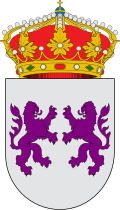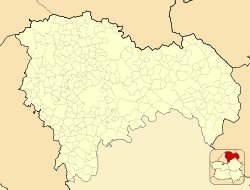Millana, Spain | |
|---|---|
 Church of Santo Domingo de Silos in Millana. | |
| Coordinates: 40°30′31″N2°34′11″W / 40.50861°N 2.56972°W | |
| Country | |
| Autonomous community | |
| Province | Guadalajara |
| Municipality | Millana |
| Area | |
• Total | 27 km2 (10 sq mi) |
| Population (2024-01-01) [1] | |
• Total | 124 |
| • Density | 4.6/km2 (12/sq mi) |
| Time zone | UTC+1 (CET) |
| • Summer (DST) | UTC+2 (CEST) |
Millana is a municipality located in the province of Guadalajara, Castile-La Mancha, Spain. According to the 2004 census (INE), the municipality had a population of 158 inhabitants.[ citation needed ]
Millana's Church of Santo Domingo de Silos is included on Spain's heritage register, in the category Bien de Interés Cultural . [2]



